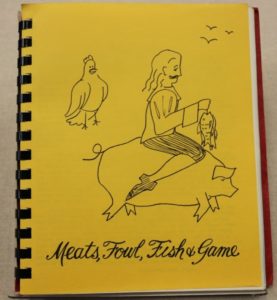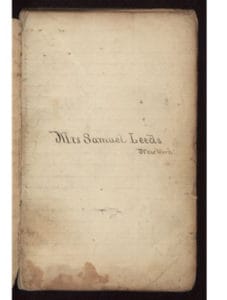The following Top 10 List is written by graduate student worker Diane Ray, with introduction by Curator Eric Ensley. Images, unless otherwise noted, are also from Diane. Eric and Diane co-curated the exhibit “Art to Eat By: Cookbooks as Record and Expression” which is on display in the Special Collections & Archives reading room September 2021.
If one takes art to mean a creative application of human skill, food and dining have long been canvases for the expression of art. Ancient frescoes and mosaics from Greece and Rome allow glimpses of tables laden with decorative plates and glasses alongside dishes that are celebrated for their beauty. Though the details and dishes may have changed, food and dining have continued to be a space for artistic output. From medieval coronation banquets with elaborate sugar sculptures known as subtleties to the technicolor party food of the 1960s, food as art has long been tied to the enjoyable and meaningful experience of dining.
Food and its ties to art are not, however, without tensions. This exhibit focuses on one of the central tensions of displays of food in cookbooks and adjacent publications: the sometimes-blurry lines between public and private space and experience. Through materials taken primarily from the Szathmary Culinary Collection donated by Chef Louis Szathmary, we show that books about food have often attempted to navigate the personal, familial, and domestic spaces of dining while displaying a public-facing image of those experiences. At question in these images is who or what should be on public display. A repeated focus of the items on display is how visible women should be and how their role should be presented in public-facing images of food and dining. Further, alongside issues of gender, these items trace the contours of the art of food and its political, artistic, and communal impact.
It was hard to choose, but here are 10 favorite things from this exhibit, in no particular order! There are many more to see if you visit us on the Third Floor of the Man Library.
1. Le Quadragesimal Spirituel (BX2170.L4 Q33 1521)
Printed in Paris around 1521, this book is unusual and fascinating on many levels. The description from the seller sums this book up as “an illustrated work of cookery, mnemonics and mysticism for women.” It goes over different food, along with that food’s spiritual meaning to guide meditation during lent. It also discusses expectations for pilgrims, with instructions about buying different religious print from street venders.
The woodblock prints are also quite unusual, including the one included here, showing the Devil offering meat to seated nobles. One could imagine the blank scrolls as speech bubbles. But probably most intriguing about this book is that it was printed by a woman under her own name. A printers widow, Jeanne Trepperel was only active under her own name for nine months– 29 September 1520 to early June 1521. While female printers were not unheard of, they were rarely named on the text.
2. Alice Toklas Cook Book (TX719 .T6 1960 , TX719 .T6 1954)
We have two copies of this cook book by Alice B. Toklas (writer, artist, partner to Gertrude Stein). This book as both a recipe book and a sort of autobiography, as it tells of her time in France during World War I, such as the hardships getting certain foods, or the different cooks and housekeepers that worked for them. The most well known aspect of this book is the famous (or infamous, depending on who you ask) ‘Haschich Fudge’ recipe. The archives has two copies of this item- the recipe is only included in the 1960 UK version.
3. Crocked, or, will the real Betty Crocker please stand up? Written by Maryann Riker (N7433.4.R556 C76 2011)
The image of the perfectly put-together, white-middle class woman, effortlessly providing for her family was presented in many cookbooks for sale back in the day, a stereotype that many artists push against now. Some, like Crocked, or, Will the real Betty Crocker please stand up? focus directly on deconstructing the personalities promoted by brands. Crocked folds up to form a house structure, and includes commentary on the history of the Betty Crocker charter, along with images of her many depictions over the years.
4. Izaak Walton League Cook Book, Des Moines Iowa (TX715.2.M53 I93 1970)
Community cookbooks are always a joy to look through because there is such a creative variety to the local collections of recipes. This character that appears throughout a cook book from Des Moines caught my eye in particular. The Izaak Walton League, sometimes shortened to “Ike”, is a conservation organization that “takes a common-sense approach toward protecting our country’s natural heritage and improving outdoor recreation opportunities for all Americans”, according to their website. This includes responsible hunting and fishing, (similar to Ducks Unlimited) and providing recipes to that end. (desmoines-ikes.com)
5. Handwritten cookbook, East Hartford (Msc 0533 US 80)
Louis Szathmary collected several hundred handwritten or personal cookbooks that are included in the Szathmary Culinary Collection at Special Collections & Archives. Most of what is on exhibit comes from this collection, and this particular item from 1818 is one of my favorites. Not only does it show how recipe books can also be outlets for creative expression, it is also unfinished (notice that some titles are only outlined, and some capitals are missing, while others are fully filled in and beautifully embellished) which is a very relatable trait.
6. Mrs. Samuel Leeds Cookbook & Travel Journal (Msc 0533 US 33)
This book includes both recipes and a short travel journal, in which Mrs. Samuel Leeds took a ship to England from Brooklyn in 1856, and was quite unimpressed for much of the trip. Highly recommended for fans of reading zero star Yelp reviews. (images from the Iowa Digital Library)
7. Funeral Food, written by Sandra Trugillo (unprocessed)
This collection of broadsides includes colorful images and text on one side, with the accompanying stories on the other. Each one talks about some aspect of food or funeral culture, in the US or Mexico. The artist describes it as “a marriage between traditional cookbooks and artists’ portfolios about material culture.”
8. Llyewelyn’s Pub, by Pat and Jack Brangle (Msc 0533, US 83)
This item is one of a collection of 7 cookbooks that were handwritten and illustrated by Pat Brangle who, along with her husband Jack, owned Llyewelyn’s Pub in St. Louis. The illustrations are very distinctive, with wonderful detail and colors.
9. Thirty Recipes Suitable for Framing, compiled by Alice Louise Waters, with illustrations by David L. Goines (FOLIO TX715 .W3315 1970)
Containing 30 different sized broadsides, each item features a beautiful colored illustration in a classic European woodblock style and a written recipe. Recipes range from orange chicken, to watercress salad, to even yogurt. But each one is tied together by the same style of illustration and calligraphy font.
10. The Iridor Complete Candy Making Course, written by Iris F. Leonard and Dorit K. Weigert. (TX791 .L38)
This collection of 6 books in a matching box from 1931 offers instructions and tips for making and selling candies. It is geared towards women looking for a job outside of being a homemaker. As the introduction says “Welcome into the nation-wide group of ambitious women who are following the Iridor Plan to win financial independence and happiness.”











